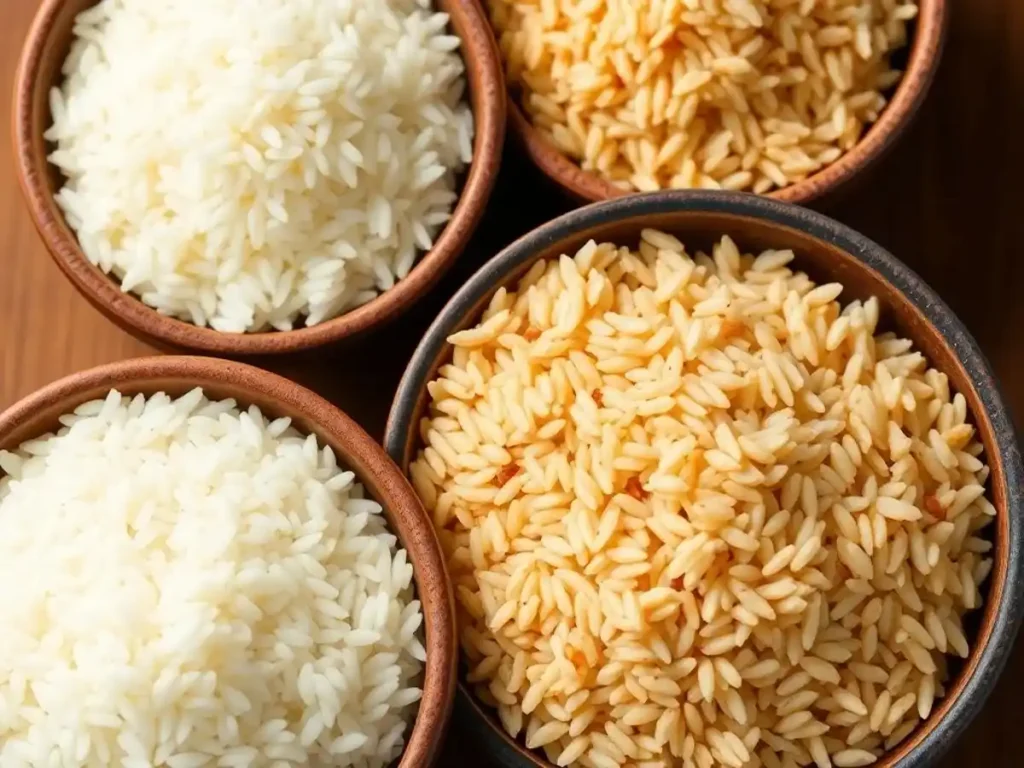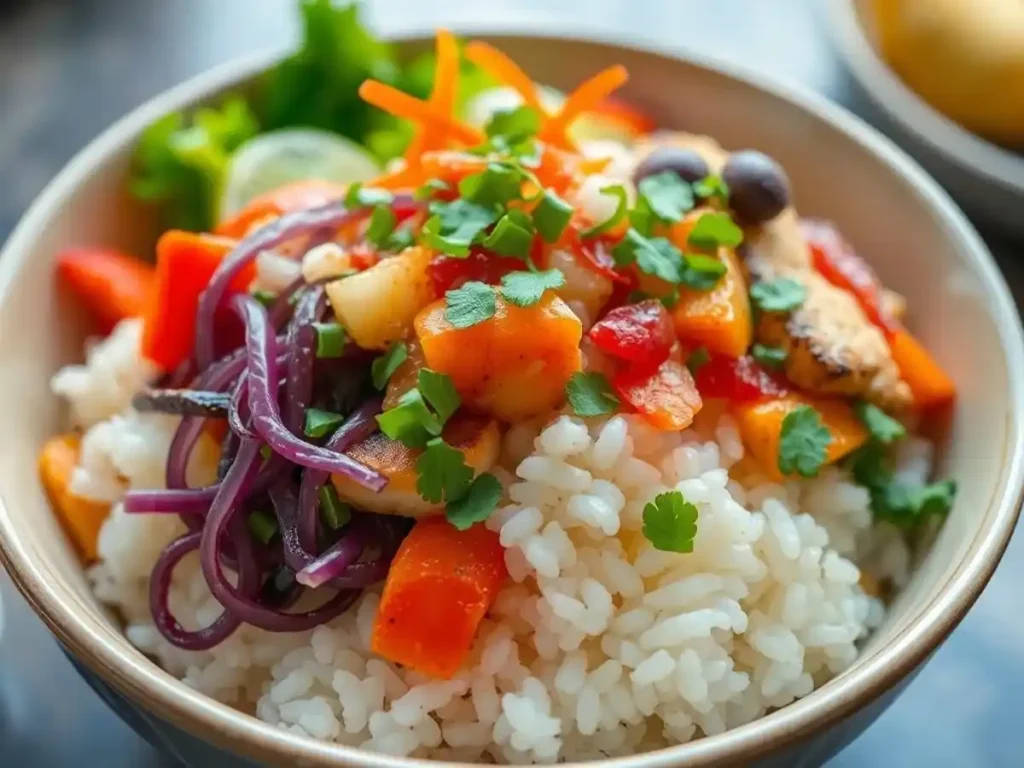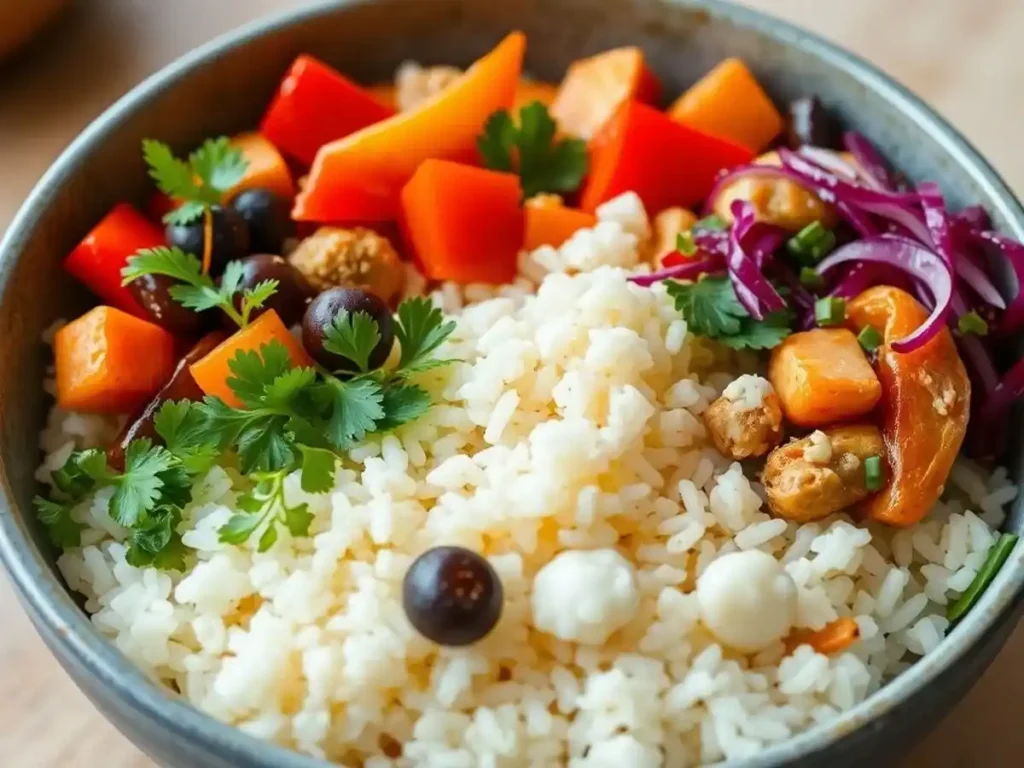Rice bowls are a staple in many cuisines, offering a simple yet satisfying meal option that can be customized to your taste. Whether you’re a fan of classic white rice or prefer the nutty flavor of brown rice, choosing the right type of rice can elevate your rice bowl game. With so many varieties available, it can be tough to decide which one suits your dish best. In this article, we’ll explore different types of rice and their unique characteristics to help you determine what type of rice is best for rice bowls.
Table of contents
Key Takeaways
- White rice is versatile and pairs well with a wide range of toppings.
- Brown rice offers a health boost with its higher fiber content.
- Short-grain rice is perfect for sticky dishes like sushi.
- Long-grain rice provides a fluffy texture ideal for side dishes.
- Unique varieties like black rice add a visual and flavor twist.
Types of Rice: A Comprehensive Overview

White Rice: Characteristics and Best Uses
White rice is the go-to for many because of its soft texture and mild flavor. It’s versatile and pairs well with a variety of dishes. Cooking white rice is usually quick, needing less water than its brown counterpart. It’s perfect for those busy nights when you need something quick and satisfying. Whether it’s a side dish or the main event in your rice bowl, white rice is a staple in many kitchens.
Brown Rice: Health Benefits and Flavor Profile
Brown rice is known for its nutty flavor and chewy texture. It’s a whole grain, meaning it retains its bran and germ, offering more fiber and nutrients than white rice. Though it takes longer to cook, the health benefits make it worth the wait. If you’re looking to add more whole grains to your diet, brown rice is a solid choice.
Short-Grain Rice: Ideal for Sushi and Sticky Dishes
Short-grain rice is famous for its sticky texture, making it ideal for sushi and other dishes where you need the rice to hold together. It’s starchy and moist, perfect for creating dishes that require a cohesive texture. If you’re experimenting with sushi at home, short-grain rice is your best bet.
Long-Grain Rice: Fluffy Texture and Versatility
Long-grain rice, like basmati or jasmine, is known for its fluffy and separate grains when cooked. Its firmer texture makes it great for pilafs and as a base for dishes with a lot of sauce. Lime rice, a popular variation, uses long-grain rice for its ability to absorb flavors without becoming mushy.
Unique Rice Varieties: Exploring Sushi and Black Rice
Beyond the common types, there are unique varieties like black rice, also known as forbidden rice. It’s packed with antioxidants and has a rich, nutty flavor. Black rice is visually striking and adds a touch of elegance to any dish. It’s perfect for those looking to try something different and nutritious.
Seasoning: Enhancing the Flavor of Your Rice
When it comes to rice bowls, seasoning is everything. The right blend of spices can turn a simple bowl of cooked rice into a flavorful masterpiece. Here’s how you can make your rice sing with taste and aroma.
Basic Seasonings
- Salt and Pepper: These are the basics. A pinch of salt can enhance the natural flavor of the rice, while a dash of pepper adds a subtle kick.
- Green Onions: Thinly sliced, they add a mild, fresh flavor and a pop of color.
- Soy Sauce: A splash of soy sauce can add a savory depth to your rice.
Adding Heat
For those who love a bit of spice, consider these options:
- Chili Flakes: Sprinkle over your rice for a hint of heat.
- Sriracha: A squirt of this hot sauce can bring a fiery touch.
- Wasabi: Perfect for those who enjoy a sharp, nose-tingling heat.
Creative Flavor Boosters
- Lemon Zest: Adds a refreshing citrus note.
- Ginger: Freshly grated ginger can provide a warm, spicy undertone.
- Garlic: Sautéed garlic can infuse your rice with a rich, aromatic flavor.
Pro Tip: Experiment with different combinations of spices and herbs to create your own signature rice bowl. Remember, the goal is to balance the flavors so that each bite is delightful.
Final Touches
Finish your rice bowl with a sprinkle of toasted sesame seeds or a drizzle of sesame oil for an extra layer of flavor. These small additions can make a big difference.
By thoughtfully seasoning your rice, you transform it from a simple side dish to the star of your meal. Whether you prefer a mild taste or a bold kick, there’s a world of flavors to explore. Let your taste buds guide you, and enjoy the delicious journey.
Portion Control: Balancing Rice with Toppings
Crafting the perfect rice bowl isn’t just about piling on your favorite ingredients. It’s about finding that sweet spot where rice and toppings complement each other. Too much topping can overwhelm the rice, while too little might leave you wanting more.
Key Tips for Perfect Balance
- Rice is the Base: Start with about a cup and a half of cooked rice per serving. This gives a solid foundation without drowning the flavors of your toppings.
- Mind the Protein: Whether you’re adding chicken, beef, or tofu, aim for a portion size of about 3-4 ounces. This keeps your bowl satisfying but not overloaded.
- Veggies for Color and Crunch: Incorporate a variety of vegetables like bell peppers, carrots, and cucumbers. These add color, crunch, and freshness, balancing the richness of your proteins.
- Sauce Sparingly: Use sauces to enhance flavor but don’t let them take over. A drizzle can go a long way in tying everything together without making your bowl soggy.
- Flavor Boosters: Don’t forget small additions like pickled onions or sesame seeds. They pack a punch without needing much space.
Remember, the goal is to enjoy every bite. Each forkful should offer a mix of textures and flavors, from the softness of the rice to the crunch of fresh veggies.
By keeping these tips in mind, you can create a rice bowl that not only looks appealing but also delivers on taste and satisfaction. Balancing rice with toppings is all about restraint and creativity, ensuring every ingredient shines in its own right.
Top Rice Bowl Toppings: Flavors and Textures

Proteins: Chicken, Beef, Tofu, and More
Choosing the right protein is essential for crafting a satisfying rice bowl. Whether you prefer grilled chicken, seasoned beef, or marinated tofu, each offers a distinct texture and taste that can elevate your meal. For those looking to mix it up, consider adding a Street Corn Chicken Rice Bowl to your repertoire. It combines grilled chicken with charred corn, offering a savory twist that pairs beautifully with rice.
Vegetables: Fresh, Cooked, and Pickled Options
Vegetables add vibrancy and crunch to your rice bowl. Fresh options like sliced cucumbers or blanched green beans bring a refreshing bite, while cooked veggies like sautéed mushrooms offer depth. Don’t forget the tangy punch of pickled vegetables; they can transform your bowl with just a few bites.
Sauces: Boosting Flavor with Dressings and Condiments
A well-chosen sauce ties your rice bowl together, enhancing the flavors of each topping. Whether it’s a spicy sriracha mayo, a tangy soy-based dressing, or a creamy tahini sauce, the right sauce can make all the difference. Remember, the sauce should complement, not overpower, the other ingredients. Consider a thicker sauce to coat the toppings without drowning the rice, ensuring a balanced taste in every bite.
Case Studies: Constructing the Perfect Rice Bowls

Meat Lover’s Rice Bowl: Ingredients and Preparation
Creating a meat lover’s rice bowl is all about balancing hearty proteins with flavorful toppings. Start with a base of perfectly cooked rice, ensuring it has absorbed just the right amount of water to be fluffy yet firm. Layer on slices of grilled beef or chicken, cooked to your liking. Consider these steps:
- Marinate your protein in soy sauce, garlic, and ginger for at least an hour.
- Grill or pan-fry the meat until it’s juicy and tender.
- Assemble your bowl with rice, meat, and add-ons like sautéed onions and bell peppers.
A drizzle of teriyaki or soy sauce ties everything together, making each bite a savory delight.
Vegetarian Rice Bowl: Flavorful Combinations
For a vegetarian twist, focus on a variety of textures and flavors. Start with a base of brown rice for its nutty flavor and health benefits. Add roasted vegetables like sweet potatoes and bell peppers. Here’s how to build it:
- Roast veggies with olive oil, salt, and pepper until caramelized.
- Add a protein like tofu or chickpeas, seasoned with cumin and paprika.
- Top with fresh herbs and a squeeze of lemon juice for brightness.
This bowl is a celebration of colors and flavors, with each ingredient complementing the next.
Mediterranean Rice Bowl: Ingredients for a Fresh Twist
Explore the fresh flavors of the Mediterranean with this rice bowl. Use long-grain rice as your base, cooked in a bit of olive oil and water for a fragrant aroma. Here’s what you’ll need:
- Grill chicken or lamb with oregano, lemon, and garlic.
- Add fresh veggies like cucumbers, tomatoes, and olives.
- Finish with a dollop of tzatziki or hummus for creaminess.
A Mediterranean rice bowl is not just a meal; it’s a journey through vibrant flavors and satisfying textures.
Each of these rice bowls highlights the versatility of rice as a base, allowing you to mix and match ingredients to suit your taste. Whether you’re a meat lover, vegetarian, or craving Mediterranean flavors, there’s a rice bowl for everyone.
Meal Prepping: Tips for Easy Rice Bowl Ready Meals
Meal prepping rice bowls can transform your weeknight lunch routine into a breeze. With a little planning, you can have healthy, delicious meals ready to go whenever hunger strikes. Here’s how to make it happen:
- Cook Rice in Bulk: Start by preparing a large batch of your favorite rice. Whether it’s jasmine, basmati, or brown rice, cooking in bulk saves time. Store it in the fridge for quick access.
- Chop and Store Ingredients: Slice your vegetables and proteins in advance. Keep them in airtight containers, separating the cooked elements from the fresh ones to maintain freshness.
- Portion Control: Divide everything into individual servings. This not only helps with portion control but also makes it easy to grab a meal on the go.
- Mix and Match: Create variety by mixing different toppings and sauces. Think about adding proteins like chicken or tofu, and a mix of fresh and roasted vegetables.
Meal prepping isn’t just about saving time—it’s about ensuring you have nutritious, balanced meals at your fingertips. With a bit of planning, your rice bowls can be both convenient and satisfying.
- Reheating Tips: When you’re ready to eat, simply reheat the cooked components in the microwave. A quick zap of 30-60 seconds should do the trick, ensuring everything is warm without overcooking.
- Storage Tips: Keep your rice bowls fresh by storing the components separately. This prevents sogginess and keeps everything tasting its best.
By following these steps, you’ll have a lineup of tasty rice bowls ready for any meal, making your weeknight lunchs both easy and enjoyable.
For those interested in a chicken breakfast burrito option, meal prepping can also include breakfast choices to ensure a protein-packed start to your day. And if you’re looking for healthy breakfast burrito ideas, consider variations that cater to different tastes and dietary needs.
Final Thoughts: Elevating Your Rice Bowl with Creativity
Creating a rice bowl is an art, and like any art, it thrives on creativity and personal touch. The key to an unforgettable rice bowl lies in the balance of flavors, textures, and colors. Here are a few tips to help you craft a bowl that not only tastes amazing but also looks like a masterpiece.
- Experiment with Ingredients: Don’t hesitate to mix and match different types of rice, proteins, and vegetables. Try adding unexpected elements like fresh herbs or a sprinkle of toasted sesame seeds for an extra layer of flavor.
- Play with Textures: A great rice bowl has a mix of textures. Combine crunchy elements like nuts or crispy onions with softer ingredients like avocado or poached eggs.
- Color is Key: Use a variety of colorful vegetables to make your bowl visually appealing. Bell peppers, carrots, and purple cabbage not only add vibrancy but also pack a nutritional punch.
- Mind Your Sauce: A well-thought-out sauce can bring all the components together. However, be cautious not to overdo it. A thicker sauce, perhaps with a cornstarch base, will cling to your ingredients and enhance the overall taste without making it too soggy.
Embrace the idea that rice bowls are a canvas for your culinary exploration. Whether you’re sticking to traditional flavors or venturing into new taste territories, the possibilities are endless.
Finally, remember that making a rice bowl should be fun and stress-free. It’s all about enjoying the process and savoring each bite. So go ahead, let your creativity run wild, and build a bowl that’s uniquely yours.
Conclusion
So, what’s the best rice for your rice bowl? Honestly, it depends on what you’re going for. If you want something sticky and perfect for soaking up sauces, go for sushi rice or short-grain varieties. They hold together nicely and give you that classic rice bowl feel. On the other hand, if you’re after something a bit lighter and fluffier, long-grain rice like basmati or jasmine might be your best bet.
They separate easily and work well with a variety of toppings. And let’s not forget about brown rice if you’re aiming for a healthier option. It’s got a nutty flavor and a bit more chew, which can add a whole new dimension to your bowl. At the end of the day, the best rice is the one that suits your taste and complements your toppings. So, experiment a little, and find what works for you. Happy rice bowl making!
Frequently Asked Questions
What are some popular types of rice for rice bowls?
Common types of rice for rice bowls include white rice, brown rice, and sushi rice. Each type has its own texture and flavor, making them suitable for different kinds of rice bowls.
How do I cook rice perfectly for a rice bowl?
To cook rice perfectly, use the right water-to-rice ratio and let it rest after cooking. This ensures the rice is fluffy and not sticky. Using a rice cooker can make this process easier.
What toppings go well with rice bowls?
Rice bowls can be topped with a variety of ingredients like chicken, beef, tofu, fresh or cooked vegetables, and different sauces to add flavor.
Are rice bowls healthy?
Rice bowls can be a healthy meal option if they include a balance of grains, proteins, and vegetables. Using brown rice or quinoa can add more fiber and nutrients.
Can I prepare rice bowls ahead of time?
Yes, you can meal prep rice bowls by storing cooked ingredients separately from fresh toppings. This way, you can quickly assemble and heat them when needed.
What is the best way to reheat a rice bowl?
To reheat a rice bowl, warm the cooked ingredients in the microwave for about a minute, then add fresh toppings. This keeps the dish tasty and the textures right.
